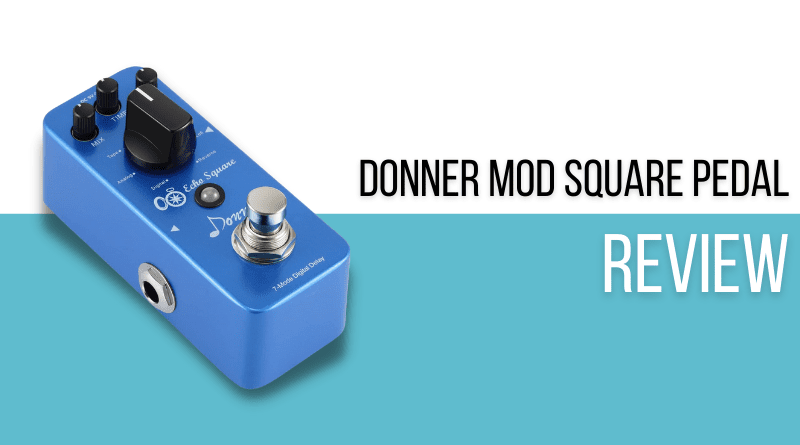Having access to modulation effects can add a huge number of textures to your tone, from subtle chorus, through to some pretty whacky tremolo sounds. There are tons of options when it comes to individual mod pedals, but having so many units can quickly clutter a pedal board and introduce additional sources of unwanted noise.
To avoid this situation, you could, of course, use a multi-mode pedal like the Donner Mod Square, a stomp box with 7 different modulation types. In this KillerGuitarRigs Review, we’ve taken a good look at the Mod Square to see whether or not it’s worth adding to your board.
Keep on reading to see what we learned!
Read more about our review process.
Want to learn more about guitar pedals?
Check out our ultimate guide to guitar pedals to find more jumping off points.
Contents
Who Is this for?
The Donner Mod Square is a budget micro pedal that offers a great introduction to FX units for beginners, but is well made enough for a working musician to trust it on their pedal board, too.
It does offer a lot of features, but more advanced players and those who rely heavily on using multiple modulation FX in their chains, or who required more fine control might want to look elsewhere.
Appearance / Features / Controls
As we briefly pointed out above this is a micro pedal – it’s a little less than half the size of the Donner Vivid Series pedals we’ve previously reviewed. Despite the small size, it’s still a substantial pedal. It has all metal construction, and even has a rubberized, non-slip bottom.
The control layout on this pedal was simple and straight forward. There were 3 adjustment dials, one for effect level, one for depth, and another for rate.
The effect level dial controls how much of the effect is applied to the signal, and acts as a blender. The depth control adjusts the height difference between the peaks and troughs on the signal. The rate knob increases or decreases the speed of the modulation by bringing each wave closer together.
The largest dial is used to adjust which type of modulation effect the pedal puts out. There are 7 to choose from, including 2 different chorus types, a phaser, tremolo, a rotary amp effect, vibrato, and a flanger.
The sturdy footswitch is used to switch the unit between on, and true bypass, which allows the signal to pass through the pedal unaffected by the circuitry.
Performance/Sound
We found the Mod Square to be a well made pedal in terms of construction and electronics quality. The true bypass was effective, with no coloration of tone when in the off position. We also found it to be nice and quiet, with no additional perceptible noise present as a result of using this unit.
We worked our way through the various pedal settings, starting with the chorus settings. Both Chorus A and Chorus B were really useable settings, and we had a lot of fun experimenting with the tones we got by adjusting the rate depth and level. We didn’t find any tone or volume loss in this setting, and we think that for the chorus alone, the Mod Square offers great value.
The Phaser setting was another favorite for us. The sweep was soft and subtle, and even with the pots maxed out, we didn’t get any weird feedback or unusual tonal changes.
Tremolo was one of the settings we didn’t much care for. It was very difficult to get a subtle effect, so even at low rate and depth levels it overpowered the signal.
We did like the Rotary effect – will it convince anybody that you’ve got a Leslie? No. But, it gets you reasonably close, with a lot less money, and a lot less space.
Of all the settings, Vibrato was our least favorite. Like the Tremolo setting, it really overpowered the signal. As soon as the effect level dial was up enough to actually hear the effect, no matter what the rate and depth dials were set to, the vibrato was too “in your face”, making it tough to realistically use.
Finally, we tested the Flanger setting. It wasn’t as good as an MXR Flanger, but if you’re trying to get some Van Halen-esque tones on a tight budget, this is a great option. We found that the controls let us dial in some great sounds, and along with the Chorus settings, we found it to be one of the most useful features of all.
If you’d like to hear the tones we got from this pedal for yourself, head on over to the KGR YouTube Channel and check out our Donner Mod Square demo
Final Thoughts on the Donner Mod Square Modulation Pedal
The Donner Mod Square might not be perfect, but that doesn’t stop us from saying that it’s still a good pedal. It’s rugged enough to survive gigging, and it’s cheap enough to pick up and experiment with on a whim – and if you choose to do that, we think you’ll probably make it a regular fixture on your board.
A couple of the settings weren’t our favorite, but the ones we liked more than justified the (low) cost of the Mod Square, so with that in mind, we wouldn’t hesitate to recommend it to anybody looking for an inexpensive modulation FX pedal.
Looking for more Donner gear? Check out:
- Donner DST-102 Electric Guitar Starter Kit Review
- Donner LP-124S Review 2022
- Donner Dark Horizon Crunch Distortion Pedal Review
- Donner White Tape Delay Pedal Review
- Donner Vowel Wah / Volume Pedal Review
- Donner Circle Looper Pedal Review
- Donner Dumbal Drive Review
- Donner Vintaverb Reverb Pedal Review


